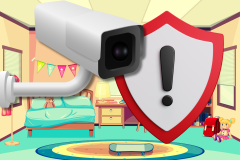The smart home is the way of the future, but it comes with its own set of risks and potential downsides. If you’re going to install some of the latest connected devices into your home, make sure you prioritize safety and security at every point along the way.
The Rise of the Smart Home
The smart home isn’t some newfangled idea or sudden inspiration. It’s been discussed and anticipated for many years. In fact, we’ve seen a variety of smart home technologies hit the market over the decades, though most have failed.
In 1967, the ECHO IV was heralded as the first smart device of its kind – supposedly able to handle shopping lists, automatically control a home’s temperature, and turn appliances on and off. It was never sold commercially, but set an early standard for the type of technology that would be expected in years to come.
It really wasn’t until the late-1990s and early-2000s that useful consumer technologies hit the market – including gadgets like programmable thermostats. And it’s just within the last two or three years that practical innovations have reached a reasonable price point. Combined with lots of marketing and consumer education, we’re finally seeing progress.
According to an IDC research report published earlier this year, the global market for smart home devices is expected to grow by 26.9 percent year over year in 2019. The growth will be sustained, with an anticipated compound annual growth rate of 16.9 percent from 2019 through 2023. The report splits smart home devices into six major categories. Here they are, ranked by 2019’s forecasted market share:
- Video entertainment (43 percent)
- Smart speakers (17.3 percent)
- Home monitoring/security (16.8 percent)
- Others (13.7 percent)
- Lighting (6.8 percent)
- Thermostat (2.3 percent)
Trends show that 2018 was all about getting products into the hands of consumers. Both Google and Amazon did an excellent job of this by really pushing their low-cost smart speakers. Now that the foundation has been laid, the focus will shift to tying devices together and creating more cohesive experiences. The trick now is to fuse together fragmented devices and services for a more friendly user experience.
The data shows that people want smart home technology – they just don’t know what to do with it yet. And those who do know what to do with it are concerned about security.
The Challenge of Security
Security is one of the chief concerns in the smart home industry – and rightly so. In theory, the idea of integrating smart home devices into the home sounds great. But when you consider that every camera, microphone, and data-aggregating device is another possible entry point for a hacker or cybercriminal, it’s easy to understand why people are skittish.
Nobody wants the feeling of being watched or listened to. We’ve heard stories of people hacking cameras and spying on homeowners; smart speakers “inadvertently” recording intimate conversations; and companies selling personal data about its customers. And even if these cases are few and far between, they’re enough to make us think twice.
Today, more than ever, we feel the pressure of balancing access with privacy. We want the latest, greatest technology, but we don’t want to open ourselves up to undue risk. With so many of our devices and accounts carefully linked together, there’s a domino effect in play whenever something happens. In today’s interconnected landscape, security issues are rarely isolated. One compromised system can lead to a complex web of problems in every area of a homeowner’s life.
7 Tips for Securing Your Smart Home
If you’re going to join the smart home fray – and you’ll almost certainly have to within the next five to seven years – you need to to ensure you’re minimizing risk across the board. Here are some tips, suggestions, and strategies to consider:
1. Only Purchase Reliable Products
Everything starts and ends with the products you purchase. If you put the right products into your home, you face a much lower risk of being compromised than if you invest in the wrong products. It’s a simple rule of thumb – but one that most people miss on.
In pursuit of reliable smart home products, nothing beats research. In addition to crowdsourcing information via social media and online message boards, use dedicated review sites. House Method – which provides homeowners with reviews, guides, and advice on everything from DIY home projects to finding the right contractors to perform certain jobs – is one of the best.
2. Stick With Protected Devices Only
Every device manufacturer and application developer relies on their own set of security features. Some place a greater emphasis on security than others. And in most cases, you get exactly what you pay for.
As a consumer and homeowner, it’s wise to familiarize yourself with security and safety standards. Some of the industry standards include ZigBee, Z-Wave, and S2. You’ll find that most of the established brands from recognizable companies follow one of these secure transmission protocols. The cheaper, off-brand devices may cut corners to save money. As a result, they don’t always have the right security frameworks in place.
3. Never Access Smart Home Network on Public WiFi
One of the useful aspects of the connected smart home is the ability to control the various systems of your home – like the thermostat, lighting, or even your kitchen oven – remotely. But if you aren’t careful, this could quickly become problematic. Never, under and circumstances, should you access your smart home network from a public WiFi connection.
When you connect to your home network via a public connection, you expose yourself to the possibility of a man in the middle attack (where hackers set up fake networks to intercept transmissions). If you fall into this trap, you could be compromised and never know it. It’s best to use a VPN or private connection whenever possible.
4. Establish Multiple Networks
Speaking of networks, be smart about how you structure your own. Most internet routers on today’s market allow you to set up two or three different networks in your home. Use this to your advantage by purposefully separating your devices.
For example, try putting all smart devices on their own network – separate from the home computer (which may have confidential information, credit cards, etc.). Furthermore, establish a guest network that you give to people when they’re visiting. It’s simple little steps like this that make a huge difference.
5. Strengthen Passwords
Believe it or not, most successful hacks are the result of compromised login details – not complex schemes where hackers backdoor their way into a system. Thankfully, all you have to do is strengthen your passwords to enhance your security and lower your susceptibility to an attack.
Strong passwords use random strings of characters – including numbers, letters, and symbols – rather than predictable words. It’s also helpful to use a combination of upper and lower case characters, which makes passcodes significantly more challenging to crack. Finally, regularly changing your passcodes – as in every few weeks – lowers your risk of being hacked.
(Side note: Stop using the same password for every account and device. If one account is hacked, you’re basically giving the hacker the freedom to access any other account on your network.)
6. Utilize Multi-Factor Authentication
In addition to strengthening your passwords, it’s recommended that you utilize multi-factor authentication for all of your smart home devices, accounts, and networks.
The most common form of multi-factor authentication is two-factor authentication (2FA). This is basically an extra layer of security that requires a username/password combo plus a second piece of information. This could be something you know (an additional pin code or security question), something you have (like a smartphone device or email account), or even something you are (like a fingerprint or iris scan).
With 2FA, it’s much harder for someone to hack into your smart home without being physically present in the home. And when you consider that the vast majority of hacks take place remotely, you can see that multi-factor authentication is a pretty powerful security mechanism.
7. Always Install Latest Updates
Nobody likes those annoying update requests, but they exist for a reason. Software updates typically address loopholes, concerns, and problems that emerge with the current version. A failure to update to the new and improved version will expose you to these risks.
The best way to handle updates is automatically. This takes the decision-making process out of the equation and ensures you’re always up to date. It’s really a no-brainer.
Be a Proactive Smart Home Owner
The smart home sector will only go as far as the security side of the industry takes it. If security innovation doesn’t keep up, this space will dry up and homeowners will move in another direction. It’s up to each of us – as homeowners and consumers – to hold tech companies accountable. This starts with utilizing the security technology we’ve been given and putting pressure on these respective organizations to keep up. We all have a part to play.










